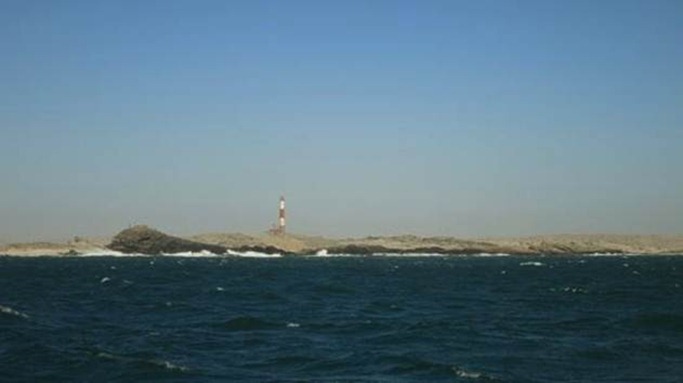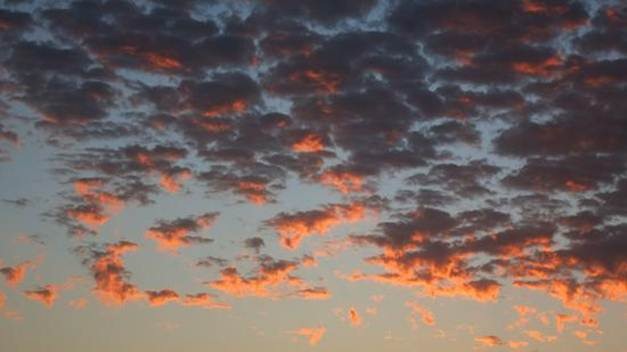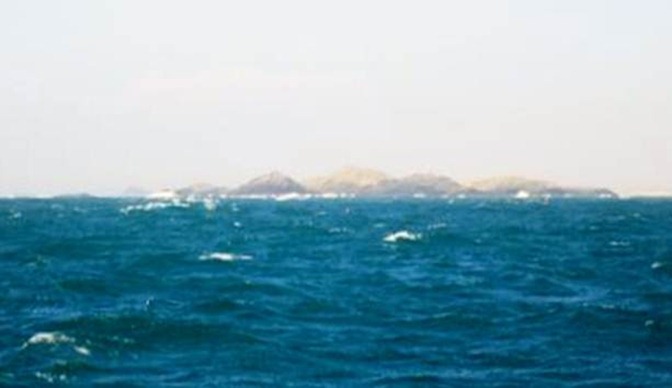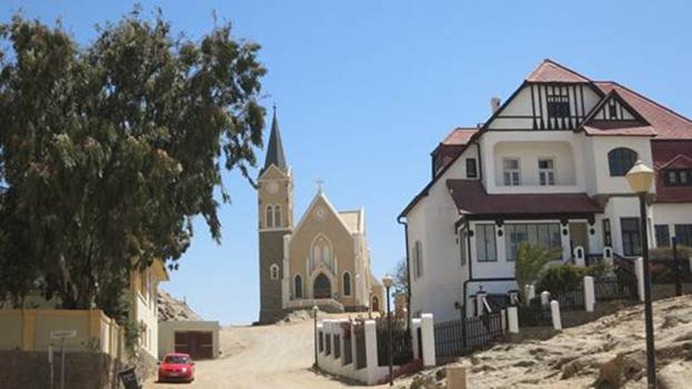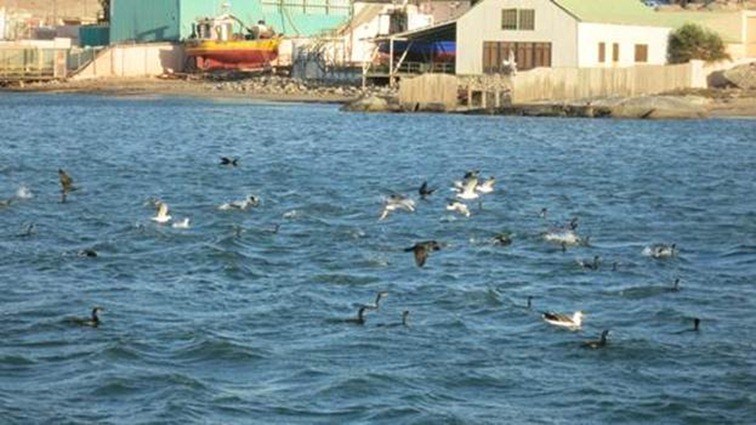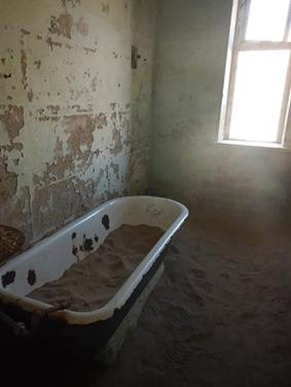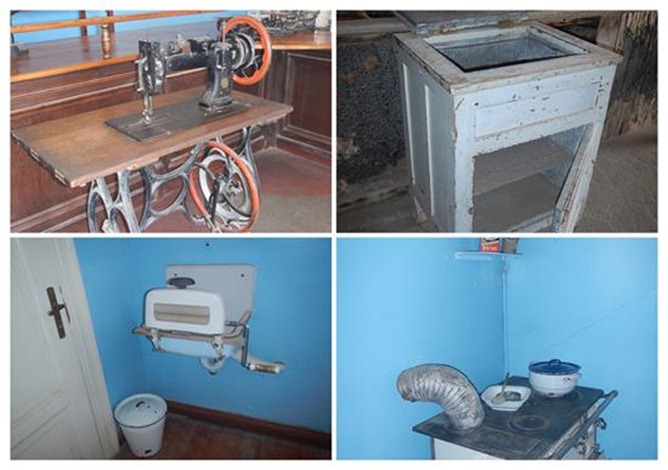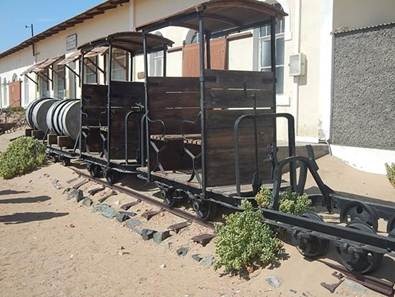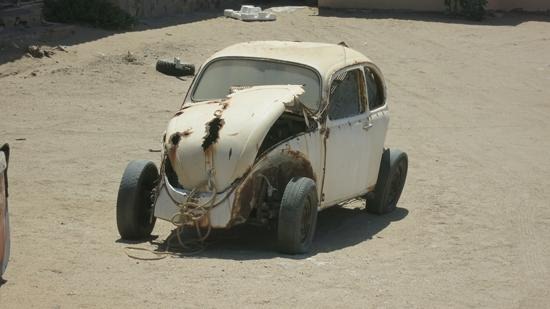Arriving in Namibia at Luderitz 26 38S 15 09E

|
Gryphon II has arrived in Namibia, in the nice harbour at the pretty ex German town of Luderitz miles from anywhere.
We had a good passage up from Cape Town keeping safely out from Namibia's wild Skeleton Coast which is peppered with wrecks. This is where the sand dunes of the world’s most ancient desert meet the rocky outcrops and crashing rollers of the South Atlantic.
Halifax Point
Evening sky over the Namib coast.
The low rocky islands are often hazy here as strands of fog threaten to roll over them.
Halifax Island
We saw three whales quite close all making great spumes as they stocked up on air. Seals and lots of sea birds, especially the low flying gannets, we just don’t want them to fly over our boat, ever! It's just less than 500 miles and we had 4 metre swells then a wind that increased to 50 knots as we were arriving at Menai Creek harbour in front of the town. We’re getting used to anchoring or mooring in a gale in African waters but Namibian winds are very cold. The weather is an odd mix as the desert is 40ºC+ but the sea is 14ºC or less because of the Benguela current bringing very cold water from the far south. The most annoying effect of this is that the wind gets very strong in the afternoon.... up to 50 knots which we experienced when we came in.
Things eventually calmed down and we enjoyed a really peaceful anchorage with few comings and goings compared to some ports we have stayed. Gryphon II is 3rd from left. We were the only visiting yacht and all the others were deserted apart from the trimaran further left which is owned by Alan who comes from Stoke on Trent but has lived here for 12 years since he came to work as a diver. Alan was extremely helpful, answering all our questions and providing us with just the information we needed to find local services easily and to understand the unusual local weather patterns. It was good to have another yachtsman about occasionally.
The town is full of interesting German architecture, a number of churches and very large and distinguished houses dating from around 1906 and onwards to about 1918. They are colourful and make for an interesting exploration of the town which is small and can be covered on foot in an hour. It seems deserted as the population is small and there are few cars and it’s definitely not busy, such a contrast to where we have just been in South Africa.
Below is The Felsenkirche (Church of the Rock), consecrated in August 1912 and one of the oldest Evangelical Lutheran churches in Namibia. Its famous stained glass windows were a gift to the Luderitz parish by the then German Emperor Whilhelm II. This gothic church stands proudly on the Diamantberg behind the Pfarrhaus (Rectory) art nouveau style house built 1909/10.
The many impressive buildings, known as the ‘diamond palaces’ were for the wealthy German entrepreneurs who came originally for what is called ‘black gold’ here, it is the guano from the thousands upon thousands of sea birds that inhabit the coastal area. The guano was, and still is, shipped out in tons as fertilizer for far flung lands. It was during this time that diamonds were discovered and the opening up of the diamond fields which are mined along this coast created even greater wealth.
This is serious diamond country where the security is quite remarkable; anchoring is allowed but it is forbidden to land on the foreshore along the coast and there are wardens around to enforce this. Luderitz lies within a vast stretch of the country which is still privately owned and the diamond fields are jealously guarded. Smuggling happens but it seems like a mad cap venture as most end up in a terrible mess. We have seen an exhibition of what people have attempted such as a shoe sandwiched with diamonds, a crossbow used to fire an arrow filled with diamonds and secretions in unpleasant places but they seem to have real experts in detection and these people are mostly caught and face nasty penalties. As well as the diamond fields there are lots of diamond dredgers and divers who scour the sea bed where many whoppers are found. The water here is brought straight up from the Antarctic with the Benguela current so we won't be making any sea bed forays, it's freezing beside which – it’s not allowed!
As well as
diamond dredging this is an important fishing harbour for Namibia so the main
craft are dredgers along with large and small fishing boats. The small fishing
boats catch crayfish and there are oyster farms here with a processing plant at
the docks. The larger boats go well out to sea and take larger catch such as
tuna and other high value fish which flourish in the cold waters here and form
part of the Namibian export market; a large proportion of the catch goes off to
Japan. The fishing fraternity do not like the many fur seals, which will bite
chunks from the catch as it is being pulled in as well as catching fish
themselves. Consequently there is an annual cull to pacify the fleet
owners. There isn’t a lot to do here, we are surrounded by desert but there are seals around us and fabulous displays from cormorants when a school of sprats come into the harbour, hundreds of them swoop and dive, they flap in the water to attract the fish and then dive on them – clever birds and the gulls join in with their fabulous aerobatics.
The sea birds starting to swarm in as the sprats come to town.
We have been out to Kolmanskop, a diamond field ghost town, and had an excellent guided tour. There were better pickings further south so the company moved everyone out. A wonderful early 20th century place with beautiful houses, a theatre, swimming pool, skittle alley, gymnasium, school, library and range of shops as well as an ice making plant. All very Germanic somehow and all standing empty in the desert and slowly filling up with sand.
Left behind.
The mule train which carried water to the houses and other buildings
They have started to take it in hand realising that it is a massive museum and can be used for tourism. Visiting is a strange experience.
The Namibians are supposed to be great drinkers of beer and other stull but we haven’t seen anything outrageous. The men drinking in the yacht club have a sort of schnapps chaser served with their beer but we’ve never stayed long enough to see the results because it gets windy and we have to dinghy back to the boat as it is cold in the evenings and getting wet would not be fun.
Low key and relaxed, Luderitz is a good place to recharge the personal batteries.
|
